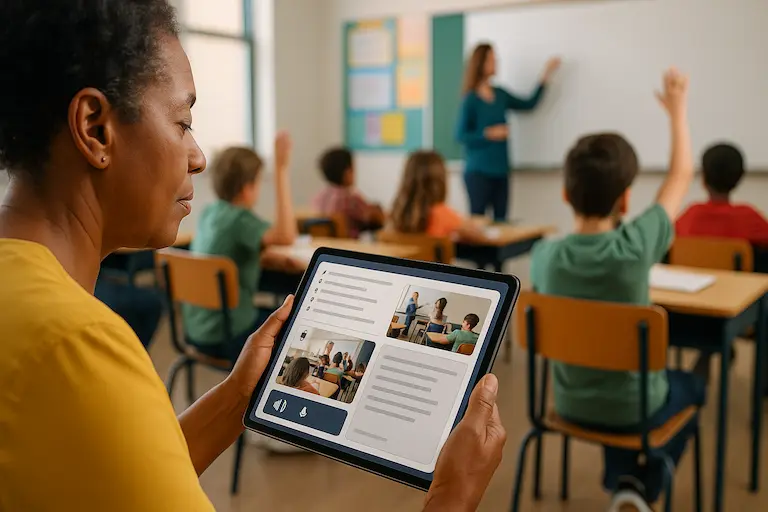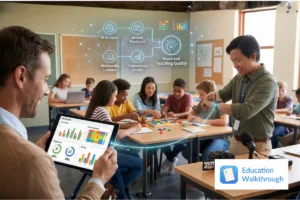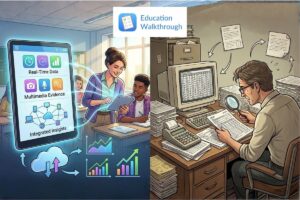For most schools, a classroom observation app is the better tool in 2025 because it provides real-time analytics, multimedia evidence, and data integration that spreadsheets cannot match.
While spreadsheets are cost-effective, apps reduce the administrative burden and convert observation data into actionable, measurable instructional insights.
This guide compares both tools, examines their core capabilities, and outlines the critical steps for successful digital adoption.
Key Takeaways
- Classroom observation apps enhance teacher evaluations by providing real-time feedback, multimedia capabilities, and integration with educational systems, thereby improving teaching practices and student outcomes.
- Spreadsheets are a cost-effective option for documenting observations but struggle with data accuracy, scalability, and real-time insights, making them less favorable than specialized apps.
- Implementing digital observation tools requires a strategic approach that focuses on training, data security, and educator engagement to ensure effective use and compliance with privacy regulations.
What Are Classroom Observation Apps and How Do They Work?

A classroom observation app is a specialized digital platform designed to replace manual forms and spreadsheets with a single, streamlined system for collecting, analyzing, and providing feedback on instructional practices.
These apps support a modern workflow where observers can capture data, multimedia evidence, and real-time notes directly from a mobile device. They are built specifically to align observations to school goals, providing clear criteria and structured observation cycles.
This shift from fragmented notes to a unified, digital approach significantly boosts teacher confidence, student engagement, and the efficacy of professional development
Core Features that Enable Real-Time Data Collection
Observation apps stand out because they are built specifically for education, not generic data entry. Popular capabilities include:
- Multimedia evidence capture (photos, audio, and snippets of lessons) to create richer documentation than spreadsheets ever could
- Customizable templates and rating scales aligned to school goals, improving consistency of teacher observations across grade levels
- Offline access + mobile device support, allowing observers to capture the data collected even without Wi-Fi
- Instant reports that help teachers track progress, identify patterns, and identify trends in their teaching practices
Because feedback is tied to specific lesson moments, teachers receive more specific feedback, making improvement easier and faster.
Education Walkthrough (EW) is a strong example. Its templates, real-time reports, and automatic email summaries reduce the time observers spend typing and increase the time they spend coaching.
Transforming Observations into Professional Growth and Efficiency
Observation apps transform classroom walkthroughs from a compliance task into a tool for professional growth. Instead of static notes that get filed away, teachers receive feedback directly connected to their lesson plans, teaching practices, and classroom goals. At the same time, school leaders reclaim valuable time by shifting from manual data collection to actual coaching and instructional support.
Key benefits for teachers and schools:
- Faster feedback that boosts teaching practices: Teachers receive suggestions immediately after a lesson so they can apply improvements in the next class rather than weeks later.
- More meaningful conversations about instruction: Feedback becomes a foundation for reflection, collaboration, and professional learning rather than just a score or rating.
- Smarter decisions based on real data: Trends help educators understand what is working, where extra support is needed, and how students are responding.
- Improved classroom management and student engagement: Actionable insights help teachers adjust routines, questioning techniques, or pacing, leading to visible gains in learning.
- More substantial alignment across the school: Teams can use the same templates, language, and instructional goals, supporting consistent expectations.
- More time for coaching and mentorship: The elimination of clerical tasks means instructional leaders spend more time modeling lessons and supporting teachers.
Even though observation apps may require a higher upfront investment than spreadsheets, they are cost-effective in the long term. They reduce clerical tasks, generate deeper instructional insights, and support measurable student growth.
What Are the Strengths and Weaknesses of Using Spreadsheets?
Spreadsheets are an accessible, low-cost option for classroom observation, but they struggle to manage the scale, speed, and analytical requirements of modern, data-driven schools.
While educators value their familiar format and simplicity for recording basic notes and classroom management data, this traditional approach quickly becomes inefficient as the volume of observations increases. Today’s instructional leaders require larger datasets, faster feedback cycles, and clearer insights into student engagement that simple spreadsheets cannot provide.
For this reason, spreadsheets are best suited for individual teachers or small teams with very limited observation requirements, rather than for school-wide professional development.
Familiarity and Low Cost Make Spreadsheets Accessible
Spreadsheets remain useful in many ways, primarily when schools work with limited resources.
Main strengths of spreadsheets include:
- Easy customization: Teachers and instructional coaches can design their own tabs, dropdowns, and labels to match their observation process.
- Familiar format: Most educators already know how to use Google Sheets or Excel, so no onboarding or training is needed.
- Low or no cost: There is no need to purchase specialized software, which matters for schools with tight budgets or in early adoption stages.
- Flexible storage and sharing: Files can be duplicated, emailed, or uploaded as needed.
For many schools starting, spreadsheets provide a low-barrier way to document teacher observations and lesson plans without investing in new tools.
Challenges with Scalability and Real-Time Data Insights
The limitations often become apparent as the volume of observations increases.
Common challenges include:
- Manual data entry increases errors and the time spent
- No automated summaries to identify trends or patterns
- No real-time feedback is sent to teachers after a walkthrough
- Hard to compare multiple lessons or classrooms across a semester
- No built-in analytics to support data-informed decisions
Instead of focusing on meaningful conversations about teaching and learning, leaders may end up spending hours sorting columns, organizing folders, and building charts from scratch.
This is also where teachers may feel frustrated because feedback is delayed, scattered across files, or not aligned with what they need to grow.
When Spreadsheets Meet Their Limit
At scale, spreadsheets track information but do not actively support teacher development. Schools often switch when they want:
- Faster cycles of observation and feedback
- Consistent formats for teacher observations across classrooms
- Automatic reminders and reports for coaching and PD sessions
- Tools that help identify patterns in instruction and student comprehension
This is the point at which digital tools are a better fit.
Platforms like Education Walkthrough automate the parts that slow leaders down. The moment an observation is submitted, the teacher receives a PDF, and the dashboard updates with trends, coverage data, and summary reports. Instead of constantly updating files, leaders get time back to support instructional coaching and professional development.
How Do Observation Apps and Spreadsheets Compare on Key Metrics?
Both classroom observation apps and spreadsheets help teachers and school leaders document instructional practices. However, they differ significantly in how well they support feedback, data collection, and professional development.
Schools deciding between a classroom observation app and a spreadsheet should compare them based on real-world classroom usability, not just cost or familiarity. The goal is not simply to record observations but to improve teaching practices, student engagement, and long-term teacher growth.
1. Ease of Use
The first significant factor in choosing the right digital tools is how simple they are to learn and use consistently. Because observation apps are designed to guide observers step-by-step, they eliminate the need for manual formatting and complex formulas required by spreadsheets. When educators are balancing dozens of responsibilities, ease of use can determine whether observations feel like support or extra work.
Before reviewing the bullets below, it’s essential to understand the practical impact: the faster observers can conduct observations, the more frequently teachers receive support and timely feedback that improves instruction.
Key points
- Observation apps let you create walkthroughs in a few clicks, instead of building forms manually.
- Ready-to-use templates eliminate the need for custom formatting.
- Spreadsheets require manual setup and formula entry, leading to inconsistencies across classrooms.
Many schools solve this challenge using Education Walkthrough, which provides mobile access and “Start a Walkthrough” prompts, so observations take seconds rather than the time spent preparing.
2. Data Collection and Management
Data collection matters because observations only lead to better teaching when insights are easy to analyze and act on. Spreadsheets store information, while observation apps turn information into insights. Apps automatically identify patterns and trends across grade levels, subjects, and classrooms, whereas spreadsheets become increasingly complex to manage as datasets grow.
Understanding this really matters because school leaders need quick access to reliable instructional data to guide professional development and student success.
Key points
- Observation apps organize data automatically and display strengths and growth areas instantly.
- Dashboards help school leaders track progress and identify patterns across classrooms.
- Spreadsheets rely on manual sorting, formulas, and formatting, which increases the risk of errors.
Real state results:
- California districts cut observation data entry time by 20 percent.
- Florida districts reduced scoring errors by 25 percent using apps instead of spreadsheets.
- New York schools sped up report turnaround times by 40 percent, allowing for faster coaching conversations.
Districts using Education Walkthrough Analytics instantly see visualizations of school-wide strengths and support needs, replacing spreadsheet analysis.
3. Feedback and Collaboration
Feedback drives change in teaching practices. Observation tools either support rapid feedback or delay it.
When teachers receive actionable input within the same week or even the same day, they can apply suggestions directly to their lesson plans and instruction. When feedback is delayed due to spreadsheet processing, that instructional opportunity is often lost.
This difference matters because the speed and clarity of feedback affect teacher confidence, classroom management, and student engagement.
Key points
- Observation apps enable real-time feedback and make scheduling coaching conversations easier.
- All observation notes are stored in a single system, enabling meaningful conversations during coaching cycles.
- Spreadsheets require emailing attachments and manual file sharing, slowing collaboration.
A 2023 study by the Texas Education Agency (TEA) showed that districts using observation apps saw a 15% increase in teacher engagement with feedback tools compared to those relying on spreadsheets.
4. Cost and Value
Cost is essential, but long-term value matters even more. Spreadsheets look free at first glance, but hidden labor costs accumulate through manual data entry, formatting, and reporting. Observation apps require an investment, but they reduce clerical workload and accelerate instructional support.
Actual value is determined by how much instructional time is protected for coaching and how many students benefit from stronger teaching.
Key points
- Spreadsheets have no license cost, but demand heavy manual entry over time.
- Observation apps reduce administrative work and provide insights that support school-wide improvement.
- Midwestern districts (IL, OH, MI) reported over 80,000 dollars in combined annual savings after switching from spreadsheets to apps.
Schools managing coaching cycles with Education Walkthrough save hours that get reinvested in instructional support rather than paperwork.
Real-Time Analytics and Actionable Insights

One of the most significant advantages of classroom observation apps over spreadsheets is their real-time analytics. Instead of waiting days or weeks to review observation notes, educators can access instant insights that support timely instructional adjustments. When data is visible immediately, classroom observation becomes a tool for professional growth rather than a documentation task.
To understand how real-time analytics impact teaching, here are the core benefits that teachers and school leaders gain during and after observations:
Key benefits
- Immediate insights help teachers refine instruction while the lesson is still fresh.
- Real-time feedback enables educators to adjust teaching strategies within the same week or even the same day.
- Data visibility creates a more responsive learning environment, where support is proactive rather than reactive.
Dashboards and trend reports transform raw observation data into actionable feedback. They help schools identify patterns and trends across grade levels, subjects, or specific teaching practices. This level of clarity is not possible with spreadsheets, which require manual sorting and formulas before trends emerge.
Case Study Highlight: Arizona School for the Deaf and the Blind
The Arizona School for the Deaf and the Blind (ASDB) is a real example of how real-time analytics can completely change the impact of classroom observation. Before adopting digital tools, walkthroughs were done on printable forms, and feedback was handwritten. Meghan Boyle could complete only one walkthrough per classroom per semester, and follow-up conversations were delayed.
After implementing the Education Walkthrough, everything shifted.
- Walkthrough frequency increased from once a semester to once a quarter, plus weekly drop-ins.
- The digital PDF feedback teachers received immediately helped them stay aligned with goals.
- Real-time data identified the classroom environment as a school-wide growth need, leading to new PD initiatives and lesson strategies.
The most significant breakthrough came from visibility. Administrators could finally see trends across 40 classrooms rather than trying to remember observations individually. Accountability and instructional momentum became natural outcomes because data were available on demand.
ASDB also benefited from Education Walkthrough’s video feature, which allowed PD content and messaging to be delivered in American Sign Language (ASL). This drastically improved accessibility for deaf and hard-of-hearing staff and became a decisive factor in platform selection.
Today, ASDB uses real–time analytics not only in walkthroughs, but in campus-wide webinars, newsletters, and planning sessions. The insights from observations directly shape professional development and coaching cycles, turning data into decision-making rather than storage.
Balancing Standardization with Classroom Customization
A strong classroom observation system must balance consistency and flexibility. School leaders need reliable criteria to ensure classroom observations are fair and objective. However, teachers also need space for unique teaching practices, lesson plans, and classroom management approaches.
Observation apps excel because they bring standardization and customization into one environment. They give schools a clearer picture of instructional quality without restricting creativity.
To create this balance, schools benefit from features that allow the observation process to follow a consistent structure while still adapting to specific grade levels, subject areas, and instructional priorities.
What standardization and customization achieve:
- They reduce uncertainty by ensuring teachers understand the expectations before teacher observations take place.
- They keep rating scales, observation notes, and look-fors aligned across classrooms, even when multiple people conduct observations.
- They allow templates to be tailored to different contexts, so feedback stays relevant to teaching practices instead of being generic or repetitive.
Observation apps make it easier to schedule classroom walkthroughs, track progress, and identify trends across a school site with just a few clicks. Many teachers report lower stress during observations when tools are standardized, supporting continuous improvement and stronger professional growth.
Education Walkthrough supports this balance through customizable digital rubrics, shared templates, and school-wide forms that prevent mixed expectations. Explore customizable walkthrough templates.
Multimedia Evidence Capture (Photo, Video, Audio)

Written notes alone cannot always show what really happened in a class. Lesson pacing, student engagement, oral responses, and movement around the room are much easier to evaluate through multimedia evidence. This is why observation apps include features that enable educators to collect and review more accurate, meaningful data.
Instead of relying only on memory or interpretation, observers can supplement the observation process with multimedia formats that support student comprehension and instructional reflection.
How multimedia enhances observations:
- Photos highlight classroom setup and instructional materials used during lessons.
- Videos allow educators to revisit lesson delivery and identify patterns in questioning, transitions, and engagement.
- Audio recordings preserve classroom dialogue and enable teachers to reflect on their own lessons at their own pace.
Multimedia evidence gives teachers more specific feedback and makes post-conference discussions more productive. When educators see and hear examples from instruction, it becomes easier to identify areas that need support and celebrate strengths that might be missed through written feedback alone.
Education Walkthrough includes image, video, and audio capture directly inside the app, creating a permanent record of data collected without the need for spreadsheet software or third-party storage tools. See how schools improve feedback quality using multimedia evidence.
Seamless Integration with Student Information Systems (SIS)
Observation apps become even more valuable when they connect smoothly with other digital tools already used in schools. Instead of working across multiple platforms or manually copying data from one system to another, integration brings everything into a single system, enabling school leaders to make more informed decisions more efficiently.
This means classroom observation data can work alongside student information, lesson plans, student engagement metrics, and assessments to show progress in instruction and students’ learning.
Why integration matters for schools:
- Automatic class roster syncing reduces the time spent preparing to conduct observations.
- Data pulled from student information systems supports comparisons between instructional trends and student success.
- Existing digital tools, such as Google Classroom or learning platforms, can be used together to track progress over time.
Schools that integrate classroom observation apps with the student information system report a significant reduction in time spent tracking data, especially compared to using Google Sheets or Google Forms. With everything centralized, the focus shifts from documentation to coaching and instructional planning.
How Can Schools Overcome Technological Barriers to Adoption?
Even when teachers see the value of observation apps, adoption can be difficult if the transition from traditional spreadsheets feels overwhelming. Successful implementation depends on thoughtful planning, clear expectations, and ongoing encouragement.
The most effective rollouts address both the technical and emotional needs of educators. Teachers need training not only on how to use digital tools, but also on how these tools support professional development and student success.
What reduces barriers to digital adoption:
- Clear starting guidelines help teachers understand how technology supports classroom observation rather than replacing professional judgment.
- Training for new teachers builds confidence before they conduct their first observations or receive feedback.
- Extra support during the first months of implementation leads to smoother adoption across grade levels and subject areas.
When schools pair digital tools with strong support, teachers feel more prepared and less anxious, which strengthens meaningful conversations after walkthroughs and raises the overall value of feedback.
Education Walkthrough provides a support center, onboarding assistance, and live chat to help educators feel less overwhelmed as they adjust to digital observation workflows.
Implementing Digital Observation Tools

Rolling out a classroom observation app should be thoughtful, collaborative, and supportive. Schools experience the strongest results when educators are invited into the process early, expectations are clear, and the purpose of the observation process is communicated as professional growth rather than compliance.
When teachers understand that digital observations are designed to elevate teaching practices rather than unfairly evaluate them, the transition becomes easier and more positive.
To guide a smooth implementation, schools benefit from anchoring the rollout in shared goals and supportive systems.
Key elements that support successful implementation
- Involving teachers during tool selection builds ownership and reduces resistance
- Professional development training strengthens technical skills and instructional confidence
- Clear privacy and data-handling expectations build trust across the entire school community
Schools that implement observation apps with intention consistently report stronger buy-in, more transparent feedback conversations, and improved consistency in teacher observations across campuses. Education Walkthrough supports this environment by offering encrypted data handling, privacy-ready infrastructure, and a permission-based access model that protects sensitive content from the moment it is collected.
How Should Schools Address Data Security and Privacy Concerns?
As digital observation tools become more common, protecting teacher and student information must always come first. Schools cannot risk data breaches or improper access, which is why strong and transparent security practices must be part of the observation system from day one. When teachers trust the security of the digital tools used to record classroom walkthroughs, feedback becomes more open, and collaboration grows.
To safeguard data effectively, schools need layered protections that support security and accountability.
How strong are data protection safeguards in schools
- Access controls limit observation data and feedback to authorized staff only
- Encryption and secure storage protect files, multimedia evidence, and student information from external threats
- Incident response planning prepares schools to take quick action if a concern ever arises
When data is protected and access is clearly monitored, schools can focus their energy where it matters most: supporting teachers, enhancing instruction, and improving student success. Education Walkthrough provides encrypted storage, modern cybersecurity technology, and a privacy-compliant data structure so schools can confidently use digital observation tools without compromising confidentiality.
Summary
Classroom observation apps offer real-time analytics, multimedia evidence, and system integrations that turn observations into actionable insights, capabilities that spreadsheets simply can’t match. While spreadsheets are familiar and inexpensive, they fall short in scalability, accuracy, and timely feedback, limiting their effectiveness for high-impact observation systems.
Digital tools create a more collaborative, responsive environment where teachers receive faster, more meaningful feedback and can continuously refine instruction. By shifting from spreadsheets to observation apps, schools set themselves up for long-term success. Education Walkthrough supports that transition with real-time feedback, customizable templates, and secure analytics that strengthen teaching and learning.
Book a demo with Education Walkthrough
Frequently Asked Questions
Quick answers to help you choose the best classroom observation method for effective feedback and teacher growth.
How have you used or how do you envision using MS Excel to support your administrative responsibilities as a teacher?
Using MS Excel can greatly enhance administrative responsibilities by enabling teachers to collaborate seamlessly through shared spreadsheets for lesson planning, attendance tracking, and budget management. Its data visualization capabilities also make reports and presentations more impactful.
What are the key benefits of using classroom observation apps over spreadsheets?
Classroom observation apps significantly enhance effectiveness through real-time analytics and multimedia evidence capture, which surpass the capabilities of traditional spreadsheets. Their streamlined interfaces and seamless system integration facilitate professional growth and informed decision-making.
How do observation apps enhance feedback and collaboration among educators?
Observation apps significantly enhance feedback and collaboration among educators by offering real-time collaboration tools that make feedback more relevant and actionable, ultimately fostering a culture of continuous improvement.
What are the challenges of using spreadsheets for classroom observations?
Using spreadsheets for classroom observations poses challenges, including manual data entry errors, time-consuming data entry, limited scalability, and a lack of real-time analytics and system integration. These limitations can hinder effective data management and analysis.
How can schools ensure successful implementation of digital observation tools?
Schools can ensure the successful implementation of digital observation tools by involving educators in the selection process, offering professional development, establishing data privacy measures, and providing continuous support and resources. This comprehensive approach will lead to more effective integration and use of the tools.



